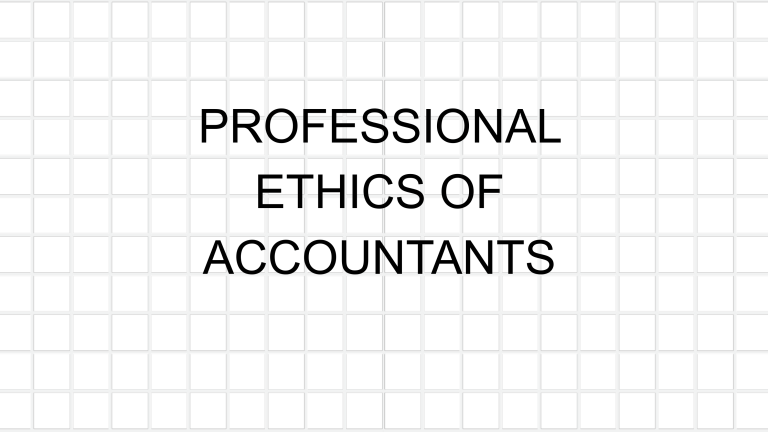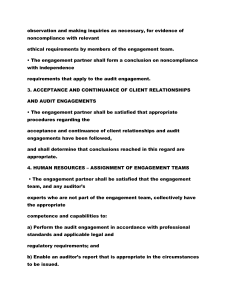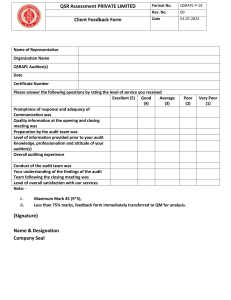
PROFESSIONAL ETHICS OF ACCOUNTANTS GROUP 2 : MUTIA SHARIFA ZULMAR 2210533038 RAHMA YONA MARSA 2210532004 SHABINA HUMAIRA M 2210532039 DEFINITION a professional is a member of an occupational group, who does the following: 1. Sees other members, including those employed elsewhere, as peers/colleagues. 2. Exercises judgment when performing specialized tasks and follows relevant professional standards. 3. Accepts the profession’s agreement to work in a morally permissible way (usually as set out in the profession’s code of ethics) as an obligation of his or her role DEFINITION Ethics can be broadly defined as a set of moral principles or values Professional ethics are the morally permissible standards of conduct that apply to the members of a particular profession. Given their position of trust, professionals are expected to conduct themselves at a higher level than most other members of society. A set of standards & rules, adopted by organizations to assist its members in understanding the difference between right & wrong and in applying that understanding to their decisions. The fundamental ethical principles are an important part of the PA’s ethical decision process. Choosing the right principles requires knowledge of professional standards, responsibilities, and expectations of ethical conduct, an understanding of the consequences, and the ability to recognize an ethical dilemma. Further, public accountants must not only be able to recognize and resolve an ethical dilemma but they must take the appropriate ethical action FRAMEWORK FOR ETHICAL DECISION MAKING Identify who is affected and how each is affected Obtain relevant facts and identify the issues Identify the ethical issues Consider and evaluate courses of action Implement the course of action ETHICAL BLIND SPOT ethical blind spot is unconscious judgmental tendencies that can hinder the ethical decision making process or cause the decision maker to fail to recognize the ethical dimension of a choice. Ethical blind spots are perhaps worse than rationalizations because the decision maker is unaware of the blind spot and it can inhibit the auditor from even recognizing an ethical dilemma in the first place. PROFESSIONAL GUIDANCE IN ETHICAL CONDUCT auditors’ decisions are made with consideration of the rules of professional conduct. The CPA code applies to all members and firms irrespective of the type of services being provided and is not restricted only to those in public practice. PUBLIC PROTECTION Section 200 of the Code of Professional Conduct represents the standards of conduct that ensure the protection of the public interest and the maintenance of the profession’s reputation. Rule 201—Maintenance of Good Reputation of the Profession The rules of accounting bodies in Canada require their members to behave in the best interests of their profession and the public interest. This means accountants should not take advantage of the trust placed in them. An accountant should not be publicly critical of a colleague (i.e., by making a complaint about th colleague’s behaviour to their professional body or by being critical, as a successor auditor, to the new client) without giving the colleague a chance to explain his or her actions first. Rule 202—Integrity, Due Care, and Objectivity Members must always remain objective, act with integrity, and continually assess and manage the risks to objectivity and integrity. The Code states that the requirement to be objective is not the same as independence. Objectivity is a state of mind. Independence is not only a state of mind; it also includes the appearance of independence, in the view of a reasonable observer Rule 203—Professional Competence Professional accoun- tants are required to attend a certain number of continuing professional education courses a year. An auditor should not undertake an audit of a client unless that auditor has knowl- edge both of that client’s business and industry, and of the technical aspects of the audit. Rule 204—Independence The value of auditing depends heavily on the public’s per- ception of the independence of auditors. The reason that many diverse users are will- ing to rely upon the PA’s audit opinion as to the fairness of financial statements is that users expect the PA to have an unbiased viewpoint. The rules of professional conduct require members who are engaged in the practice of public accounting to be indepen- dent when they perform assurance services and specified auditing procedures engage- ments. Rule 205—False and Misleading Documents and Oral Representations No mem- bers, whether in public accounting or industry, can sign or associate with false or misleading information (this includes letters, reports, and written or oral statements) or fail to reveal material omissions from financial statements. Rule 206—Compliance with Professional Standards PAs are required to comply with professional standards when preparing and auditing financial statements. These stan- dards include the standards of the professional body but, more importantly, account- ing standards and GAAS as set out in the CPA Canada Handbook—Assurance. Rule 208—Confidentiality of Information The rules of conduct for PAs state that members shall not disclose any confidential client information or employer informa- tion without the specific consent of the client or employer. The rules also prohibit using confidential or inside information to earn profits or benefits. The confidential- ity requirement applies to all services provided by public accounting firms, including tax and management service Rule 210—Conflicts of Interest If an auditor is asked to provide assurance services for two or more clients who are competitors, then the auditor needs to obtain consent from each client and must also use procedures to protect confidential information. Rule 211—Duty to Report Breaches of the CPA Code The CPA Code of Conduct of the professional accounting bodies requires members who are aware of another mem- ber’s breach of the rules to report to the profession’s discipline committee after first advising the member of the intent to make a report Rule 215—Contingent Fees The charging of a fee based on the outcome of an audit, such as the granting of a loan by a bank, could easily impair the auditor’s indepen- dence. Contingent fees are prohibited for audits, reviews, compilation engagements, and any other engagements that require the auditor to be objective. Rule 217—Advertising, Solicitation, and Endorsements A profession’s reputation is not enhanced if the members openly solicit one another’s clients or engage in advertising that is overly aggressive, selflaudatory, or critical of other members of the profession or that makes claims that cannot be substantiated. Rule 218—Retention of Documentation and Working Papers The PA has an obligation to retain documents for a reasonable period of time. This is necessary to properly carry out professional services as well as in case of litigation, practice inspections, or disci- plinary hearings. Professional Colleagues The preamble of the CPA Code of Conduct emphasizes that the following fundamen- tal principles should guide collegial relations: that client interests are placed ahead of the interest of the member or firm and that professional courtesy and cooperation are expected at all times. The two rules : • Rule 302—Communication with Predecessor • Rule 303—Provision of Client Information THE INDEPENDENCE STANDARD FOR ASSURANCE ENGAGEMENTS A. Are Services or Circumstances Prohibited? Prohibitions serve as an effective means to prevent independence threats. In some cases, the prohibition does not mean that the firm cannot take on the engagement; rather, it means that the individual affected cannot take part in the engagement. THE INDEPENDENCE STANDARD FOR ASSURANCE ENGAGEMENTS B. Prohibitions for All Assurance Engagements The following are prohibitions applicable to all assurance engagements: • Members of the engagement team (and immediate family members) may not have a direct or material indirect financial interest in the entity subject to the assurance engagement. • The firm or members of the engagement team may not have a loan from or a loan guaranteed by the entity (except in normal course of business, e.g., a bank). • The firm and members of the engagement team cannot have a close business relationship with the entity, a related entity, or management (unless the financial interest is immaterial) THE INDEPENDENCE STANDARD FOR ASSURANCE ENGAGEMENTS B. Prohibitions for All Assurance Engagements The following are prohibitions applicable to all assurance engagements: •Members of the engagement team may not have an immediate family member who is an officer or director of the client, who is in a position to exert significant influence over the subject matter, or who has an accounting role or financial reporting oversight role. • A member of the engagement team must not serve as a director or officer during the period covered by the assurance report. • Members and firms are prohibited from performing management functions (unless the entity’s management directs and supervises their work). THE INDEPENDENCE STANDARD FOR ASSURANCE ENGAGEMENTS B. Prohibitions for All Assurance Engagements The following are prohibitions applicable to all assurance engagements: • Members of the engagement team must obtain client approval for making journal entries and accounting classifications. The creation of original or source documents such as cheques and invoices is prohibited. • Members and students on the engagement team and the firm may not accept other than insignificant gifts or hospitality from the assurance client. • Key audit partners cannot be evaluated or compensated based on selling non assurance services. (Key audit partners include the lead engagement partner, the engagement quality control reviewer, and other partners who make key decisions or judgments with respect to the audit.) Prohibitions Specific to Listed Entities The following prohibitions are only applicable to listed entities: • A member or a firm cannot perform an audit if a person who would participate in the audit is an officer or director or is in a financial reporting oversight role of the entity (unless a year has elapsed since the date the financial statements were filed with the relevant securities regulator). • The firm cannot perform an audit if the chief executive officer (CEO) of the audit firm is an officer or director or is in a financial reporting oversight role of the entity, unless a year has elapsed since the person was the CEO of the firm. • Key audit partners must leave the audit team after seven years. Lead partners cannot participate in the engagement for that particular company until five years have elapsed, and other key partners must wait until two years have elapsed. Prohibitions Specific to Listed Entities The following prohibitions are only applicable to listed entities: • Unless specific measures are taken, firms are prohibited from performing the financial statement audit if 15 percent of the firm’s total revenue comes from a listed entity for two consecutive years. • Firms cannot provide actuarial or human resources services, and they cannot provide tax calculations for purposes of preparing audit entries. In the case of valuation services, if they will be subject to audit procedures, they are prohibited regardless of materiality C. Identify Threats • Self-interest threat—a threat to independence where the member has a financial interest in the client or in the financial results of the client. 2. Advocacy threat—a threat to independence where the firm or member is perceived to promote (or actually does promote) the client’s position. 3. Self-review threat—a threat to independence where the PA is in the position of having to audit his or her own work during the period. 4. Familiarity threat—a threat to independence that occurs when it is difficult to behave with professional skepticism during the engagement. 5. Intimidation threat—a threat to independence that occurs when the client intimidates the public accounting firm or its staff with respect to the content of the financial statements or with respect to the conduct of the audit. Evaluate the Significance of the Threat When the PA assesses the significance of the threat, she considers whether there are any safeguards that will eliminate or reduce the threat to an acceptable level. The Rules of Professional Conduct define an acceptable level as the level where a reasonable observer would likely conclude that independence is not compromised. Identify and Apply Safeguards Safeguards by the Profession and Legislation - include rules regarding partner rotation, partner compensation, limits on the percentage of a firm’s revenue from one client, and specific prohibited services. Safeguards at the Client - Safeguards at clients can include policies that prohibit certain services and/or that encourage ethical conduct.One of the key client safeguards is competent accounting staff.The other key safeguards are related to the audit committee. Safeguards at the Firm - Public accounting firms have in place a range of safeguards to ensure independence. These include employee training programs, peer reviews,client acceptance, and continuance policies that help to identify threats, and engagement quality reviews. For Each Identified Independence Threat, Document How It Was Resolved For each new and ongoing assurance engagement, audit engagement management, such as the partner and the manager, are required to evaluate, in writing, the independence of the firm and the staff assigned to the engagement. This formal independence threat analysis forms part of the documentation for the engagement. The documentation should include the threat, a description of the safeguard to eliminate or reduce the threat to an acceptable level, and how that safeguard eliminates or reduces that threat to an acceptable level. ENFORCEMENT OF THE CODE OF PROFESSIONAL CONDUCT Expectations gap is the gap between public expectations of the auditor’s role and responsibilities and the auditor’s responsibilities per GAAS. Reducing the Expectations Gap The performance gap can be reduced by the following: • Standard Setting—To address the deficient standards gap, the IAASB and CPA Canada strive to set and revise standards. For example, the auditing standards on auditor’s responsibility to detect fraud were issued to address users’ needs and expectations of auditor performance ENFORCEMENT OF THE CODE OF PROFESSIONAL CONDUCT Reducing the Expectations Gap The performance gap can be reduced by the following: • External Monitoring— external inspections conducted by provincial CPA organizations and CPAB ensure public companies follow audit standards and help them improve their level of performance. Further, in instances of improper conduct and performance, there must be appropriate sanctions. • Firms’ Quality Control Systems—While external monitoring helps to improve performance, to ensure that all public accountants perform their work to a satisfactory standard on every audit, effective firms must have effective quality control systems. The reasonableness gap can be reduced by the following: • Standard Setting—Revising and developing new standards to address users’ needs and expectations also helps to address the reasonableness gap. • Educating Society about the Role of the Auditor—To reduce the reasonableness gap, CPA Canada, leaders of public accounting firms, and educators should educate investors and others who read financial statements about the meaning of an auditor’s opinion, and the extent and nature of auditors’ work. AUDIT FAILURE AND AUDIT LIABILITY Audit failure occurs when the auditor issues an inappropriate audit opinion as the result of an underlying failure to comply with the requirements of generally accepted auditing standards (GAAS). Audit risk is the risk that the auditor will conclude that the financial statements are fairly stated and an unqualified opinion can therefore be issued when, in fact, they are materially misstated. Audit risk is unavoidable, because auditors gather evidence on a test basis and because well-concealed frauds are extremely difficult to detect. MAJOR SOURCES OF AUDITOR LIABILITY Auditors have a responsibility under common law to fulfill implied or expressed contracts with clients. They have legal liability to their clients for negligence and/ or breach of contract should they fail to provide the services or should they fail to exercise due care in their performance. HOW PUBLIC ACCOUNTANTS CAN MINIMIZE LITIGATION RISK Public accountants may also take specific action to minimize their liability. Below are some of the key actions: • Deal only with clients possessing integrity. A PA firm needs procedures to evaluate the integrity of clients and should dissociate itself from clients found to be lacking integrity. • Maintain independence. Independence is more than merely financial. Independence requires an attitude of responsibility separate from the client’s interest. The auditor must maintain an attitude of healthy professional skepticism. • Understand the client’s business. In several high-profile litigation cases, the lack of knowledge of industry practices and client operations has been a major factor in auditors failing to uncover misstatements. • Perform quality audits. Quality audits require that auditors obtain appropriate evidence and make appropriate judgments about the evidence. • Document the work properly. The preparation of good audit documentation helps the auditor perform quality audits. If an auditor has to defend an audit in court, quality audit documentation is essential, and should include an engagement letter and a representation letter that define the respective obligations of the client and the auditor. • Exercise and maintain professional skepticism. Auditors are often liable when they are presented with information indicating a problem that they fail to recognize. Auditors need to strive to maintain a healthy level of skepticism, one that keeps them alert to potential misstatements, so that they can recognize misstatements when they exist.




